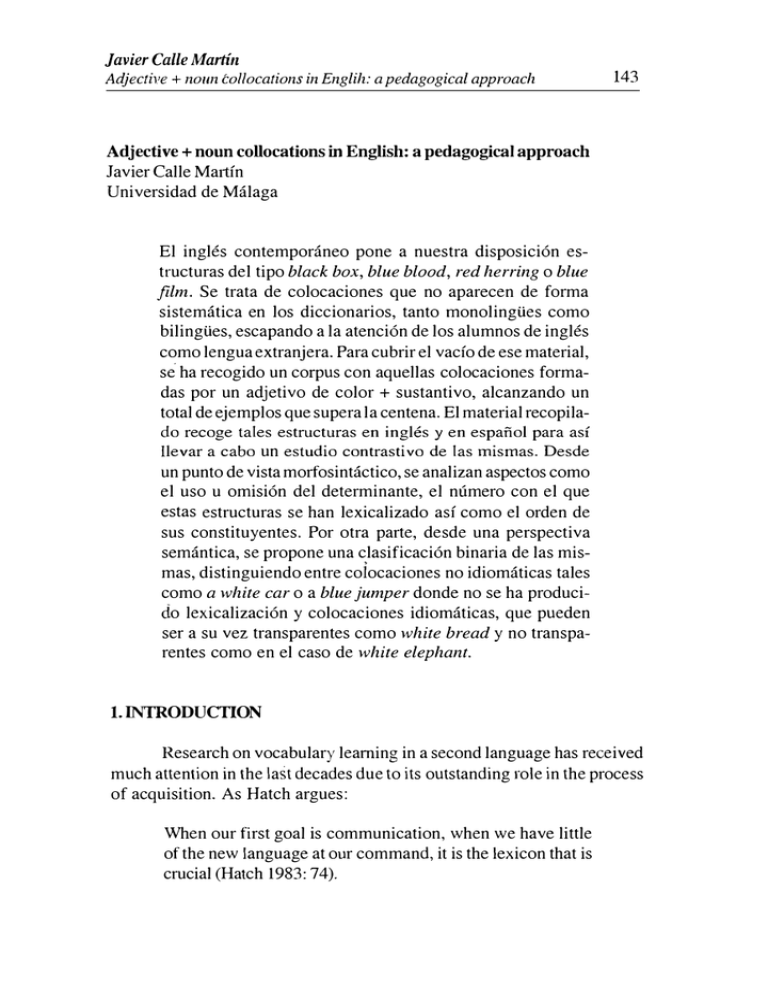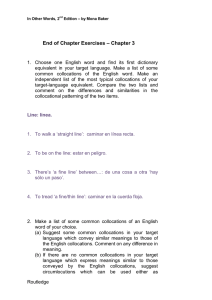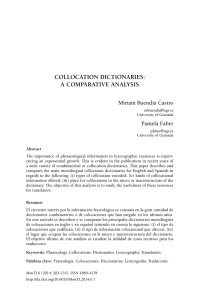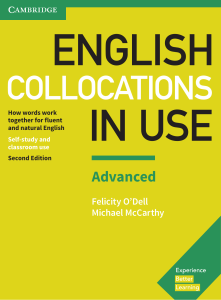Javier Calle Martín Adjective + noun collocations in
Anuncio

Javier Calle Martín Adjective + noun tollocations in Englih: a pedagogical approach 143 Adjective + noun collocations in English: a pedagogical approach Javier Calle Ma1tín Universidad de Málaga El inglés contemporáneo pone a nuestra disposición es­ tructuras del tipo black box, blue blood, red herring o blue film. Se trata de colocaciones que no aparecen de forma sistemática en los diccionarios, tanto monolingües como bilingües, escapando a la atención de los alumnos de inglés como lengua extranjera. Para cubrir el vacío de ese material, se ha recogido un corpus con aquellas colocaciones forma­ das por un adjetivo de color + sustantivo, alcanzando un total de ejemplos que supera la centena. El material recopila­ do recoge tales estructuras en inglés y en español para así llevar a cabo un estudio contrastivo de las mismas. Desde un punto de vista morfosintáctico, se analizan aspectos como el uso u omisión del determinante, el número con el que estas estructuras se han lexicalizado así como el orden de sus constituyentes. Por otra parte, desde una perspectiva semántica, se propone una clasificación binaria de las mis­ mas, distinguiendo entre colocaciones no idiomáticas tales como a white car o a blue jumper donde no se ha produci­ do lexicalización y colocaciones idiomáticas, que pueden ser a su vez transparentes como white bread y no transpa­ rentes como en el caso de white elephant. 1. INTRODUCTION Research on vocabulary leaming in a second language has received much attention in the last decades due to its outstanding role in the process of acquisition. As Batch argues: When our first goal is communication, when we have little of the new language at our command, it is the lexicon that is crucial (Hatch 1983: 74). 144 BABEL-AFIAL, 11/Auo 2002 Vocabulary leaming has proven to be an essential part in the leaming of a second language, but for vocabulary we must understand not only isolated words but also multi-word constructions such as idiomatic and stereotyped collocations. Examples of ADJECTIVE + NOUN collocations, such as a red jumper, blue blood, yellow press, white paper, etc., abound in present-day English but while the first has a direct non-idiomatic meaning, which can be understood easily, the others are idiomatic and, hence, they are not the sum of the two constituent parts, causing poor style and mis­ understandings to non-native speakers of English (Blum and Levenston 1978). The failure io use expected collocations and the occasional use of items that do not collocate are common indicators that a person who speaks a language fluently and with grammatical accuracy is not actually a native speaker. The leaming of the potential collocability oflexical items probably takes place only through considerable exposure to the language (Wilkins 1981: 22). In the course of this paper we are going to concentrate our attention on ADJECTIYE + NOUN collocations, especially those ones where the adjective denotes colour, examples of which are illustrated below: • • • • • white night � a sleepless night green back � a dallar black shirt � a fascist yellow belly � a coward black swan � something extreme/y rare blue film � a pomographic film The same phenomenon can also be found in most languages, as in the following examples taken from Spanish: • • • • casaca roja � a XVIII century soldier calcetines negros ---? a symbol o.f purity medias azules � to act as a bawd ejército rojo � the commwzist army arma blanca ---? side arms dinero negro � illegal money Javier Calle Martín Adjective + noun collocations in Englih: a pedagogical approach 145 These stereotyped collocations have not received the treatment they deserve in dictionaiies, either monolingual or bilingual. For that reason, we compiled a corpus (containing more than one hundred examples) of such collocations in Spanish and English so that a contrastive analysis couid be carried out. Therefore, the present paper presents 1) the analysis and classification of stereotyped collocations of colour and 2) sorne techniques to help students comprehend these phenomena and ease their understanding. 2. IDIOMATIC COLLOCATIONS.MAINFEATURES 2.1. Constituents and position Both in English and in Spanish, ADJECTJVE + NOUN idiomatic collocations are made up of a determiner (including zero determiner), an adjective placed in an attributive position in English or a predicative position in Spanish plus a noun (either singular or plural). For instance: • • white fish, red nose, white death, brown ale in English dinero negro, arma blanca, medias azules, manos blancas in Spanish In English, ADJECTIVE + NOUN idiomatic collocations are mainly iexicaiized with the adjective premodifying the noun which functions as the head of the noun phrase (Quirk 1972: 246-50). These constituents are usualiy referred to as node and collocate(s)1• However, there are exampies where the adjective follows the head of the noun phrase, as in the case of French loans: • carte blanche2 Regarding the use of determiners, in English stereotyped collocations usually follow the same rules as in ordinary noun phrases, but there are cases where their absence may denote a higher leve! of fossilization. So, we can say a blue book. two blue books but we cannot say *blue book. Similarly, we can say the collocation red tape (meaning 'bureaucratic formalities which siow down people') but we cannot say *a red tape. In Spanish, however, the absence of articles may denote, in sorne 146 BABEL-AFIAL, 11/Ano 2002 cases, a higher leve! of fossilization as in ponerse medias azules or in manos blancas no ofenden. In Spanish, on the other hand, NOUN + ADJECTIVE idiomatic collocations present the same constituents as in English, though the adjective appears in a postmodifying position. Sorne examples can be found where the adjective can be placed in both positions, which may imply a slight change of meaning, as in : • • las Navidades blancas � las blancas Navidades la paloma blanca de la paz � la blanca paloma de la paz3 Both in English and Spanish, the noun acting as the node in these idiomatic collocations can appear in singular and plural, as in: • • black flag � bandera pirata black flags � bander.as piratas Sorne of these structures have lexicalized either in the singular or plural owing to the fact that an uncountable or a plural noun is used. The BBC English Dictionary is the only one which contains these features showing which ones are lexicalized in the singular and which ones in the plural. For instance: • • • 2.2. black/white magic � magia blanca/negra black sheep � oveja negra blue jeans � vaqueros azules Form Idiomatic collocations may be represented as follows: a) Separated: This is the most numerous group where the node and the collocate are separated by a space. They are usually pronounced with two primary stresses, one on the collocate and the other on the node. Examples: • • black box � an electronic device in an aircraft brown Job � a soldier Javier Calle Martín Adjective + noun collocations in Englih: a pedagogical approach • • 147 greenfingers � successful at gardening white night � a sleepless night b) Hyphenated: The collocates in this type of collocation are written with a hyphen in between. They represent an intermediate step between separated and joined collocations and are usually pronounced with a secondary stress on the collocate and a primary one on the node, as in the following instances: • • • blue-gum � a tree of the genus Eucalyptus brown-study � meditation black-mouth � liar e) Joined: Initially, sorne of them might have been actual collocations which have evolved into compound nouns, where both the collocate and the node are written together, as in: • • • • • • blackberry blackmail whitebait whitesmith whitethroat yellowbird They are usually pronounced with a primary stress on the collocate, hence causing the subsequent shortening and centralization of the vowel in the node, as in blackboard ["bl&kb@d] as compared with black box ['blcek 'b0ks]4• 2.3. Idiomatic and occasional collocations: a test To distinguish between occassional collocations and idiomatic collocations the following operations can be used: a) To place the intensifier very in front of the adjective. Idiomatic collocations cannot be intensified by placing very in front of the adjective, for example, we can saya redjumper, a ve1y redjumper but not "very red tape. BABEL-AFIAL, 1 1 /Ano 2002 148 b) To change the adjective into the comparative or superlative degrees. In idiomatic collocations the adjective cannot be gradated. For instance, we can saya redjumper, a redderjumper, the reddestjumper but not *redder tape, reddest tape. Notice how the metaphoric meaning of the structure vanishes when using these procedures. For instance, the collocation white elephant denotes a very specific meaning, that is, "a waste of money on something that is completely useless" (Sinclair 1993). Yet, if we use *a very white elephant and *the whitest elephant, though grammatically correct, the idiomatic meaning disappears as they convey just the meanings of their constituent parts. 3.SEMANTIC CLASSIFICATION In this paper we have made a distinction between non-idiomatic collocations such as a blue jumper or a white car and idiomatic collocations such as black magic or white death. Ifthe leve! of Iexicaiization is taken as a criterion, idiomatic collocations can be classified into: a) Free collocations: the collocates may be easily changed. b) Restricted or semi-fixed collocations: the collocates may be changed with ce1tain restrictions. e) Stable collocations: the collocates cannot be changed as they are completely fossilized. However, from a contrastive point of view, a new classification can be proposed by distinguishing between transparent idioma tic collocatlons and non-transparent idiomatic collocations. a) Transparent idiomatic col!ocations exhibit a mimetic structure (adjective + noun in English � noun + adjective in Spanish). They express an identical or similar meaning in both languages because the two collocates are used with their basic non-metaphoric meaning, that is why transparent idiomatic collocations are not problematic for foreign leamers of English. Javier Calle Martín Adjective + noun collocations in Englih: a pedagogical approach 149 For instance: • • • • • white flag� bandera blanca white wine�vino blanco red wine� vino tinto blue cheese�queso azul black pepper�pimienta negra In sorne cases, there are changes either in English or in Spanish: • • • • • • • • • • black bread�pan negro (de centeno) white bread�pan blanco (de trigo) brown paper�papel de estraza (de envolver) bee honey�miel blanca (de abeja) cane honey�miel negra (de caña) butter beans�judías blancas garlic soup� ajoblanco fish soup�emblanco polar bear� oso blanco milk chocolate� chocolate blanco (con leche) As shown, in transparent idiomatic collocations the metaphoric meaning is identical or similar in both languages owing to the fact that the speakers of English and Spanish actually share the same philosophy, the same habits or even the same ideas of lífe as in the following examples: • • • • • • black magic �magia negra black market�mercado negro blue blood�sangre azul black humour�humor negro red devils�diablos rojos whíte death � muerte blanca (por asfixia) b) Non-transparent idiomatíc collocations. on the other hand, do not exhibit a mimetic structure or similar metaphoric meaning in both languages. Due to the specific meaning conveyed, they can only be used in particular occasions and may cause man y lexical misunderstandings to non-native speakers ofEnglish. The Oxford Dictionary on CD-ROM is of 150 BABEL-AFIAL, 11/Ano 2002 great help to find out their rnetaphoric rneanings, showing how rnost of thern were aiready lexicalized in both the Old and the Middle English period. • • • • • • • • • • • • red nose 4 nariz de bebedor white elephant 4 elefante blanco white city 4 ciudad de diversión blue film � película verde blue jacket � marinero de guerra blue print � papel carbón (de calco) blue water � alta mar green sand � arena húmeda amber fluid � cerveza australiana black frost 4 helada sin escarcha white spirit 4 aguarrás black rain � lluvia ácida As shown above, whereas sorne of the English non-transparent idiornatic collocations rnay have lexicalized differently in Spanish, sorne others do not find a counterpart in the Spanish language. For instance: • • • • • • • black spy 4 the devil golden handcuff � payment made to an employee to resist outside offers green paper 4 a government document in wlzich a propasa! or idea is put far discussion red tape 4 bureaucratic formalities which slow down people grey area 4 a geographical area showing low employment but not poor enough to qualify far special assistance black Maria 4 a vehicle used by the police to can)' prisoners white horse 4 a wave at sea with a white top In sorne other cases thé collocations are lexicalized differently in the other language: • • linen 4 ropa blanca electricity 4 hulla blanca Javier Calle Martín Adjective + now1 collocations in Englih: a pedagogical approach 151 4. LEXICOGRAPHIC ANDDIDACTICAPPROACH We have also analysed how these idiomatic collocations are treated in monolingual and bilingual dictionaries such as the Longman Dictionmy of Contemporary English, Third Barnhart Dictionary of New English, The Macquarie Dictionary of New Words, A Concise Dictionary of English Slang, English Idioms, Diccionario de la RAE and Diccionario de Uso del Español, coming to the following conclusions: a) English editors are more interested in including these structures in their dictionaries. b) There is not a homogeneous and systematic treatment of idiomatic collocations i n the dictionaries with respect to the entry and the typographical features employed. W hereas English dictionaries usually present stable collocations with independent and separated entries (or seldom as a subentry under the constituents)5, Spanish dictionaries usually include them in a subentry under any of the constituents, choosing one or another depending on the leve! of lexicalization of the collocation. However, as Battenburg states, "a common problem with both collocations and idioms is in determining how fixed they are in a Ianguage. Idiomaticity, in fact, must be considered within a continuum or a scale" (Battenburg 1991: 65 66). The wordsfixed and idiomaticity are key words given the difficulty to measure the degree of Iexicalization of a noun-phrase. Spanish dictionar­ ies usually include stable collocations under the entry of one of its constituents, either the noun or the adjective, and with this method Spanish Iexicographers distinguish between free and stable collocations showing their leve! of Iexicalization, sometimes typographically by using versalite or capital letters. English dictionaries, on the other hand, present stable idiomatic collocations as independent entries, or as subentries of the noun and/or the adjective especially when lexicographers are not certain about the stability of a collocation. This treatment may help the students realize which word is the most important and grasp their specific meaning. - Our point of view is that fixed/stable collocations should be collected as independent entries because, in this way, students could really appreciate the relationship between the collocation and its constituents and, what is more important, they get to realize the idiomaticity of the structure avoiding thus frequent Iexical mistakes. 152 BABEL-AFIAL, 11/Ano 2002 Another aspect that we have noticed is that sorne dictionaries such as A Concise Dictionary of English Slang do not employ examples which clarify the meaning and use of the idiomatic collocations. However, "language learners do not simply need to be alerted to the fact that these collocations [1,4] exist; they need also to be shown how related phrases differ semantically and pragmatically from one another" (Battenburg 1991: 67). Besides, the definitions of idiomatic collocations usually involve figurative and idiomatic meanings which are difficult to grasp for second language learners and hence, they should be illustrated with selected examples. Many of the dictionaries consulted define idiomatic collocations by just quoting out-of-context printed material (mainly from newspapers) which sometimes may become soinewhat artificial and difficult to understand. A call is made here far second-language teachers to consider these idiomatic collocations for class discussion. T hey should make an effort to introduce them in their lessons to avoid misunderstandings and lexical mistakes. From a didactic point of view, we propose the following techniques which can help the students comprehend this linguistic phenomenon: l. To make a list of constructions with the pattern adjective + noun in their mother tongue and analyse the constituent parts (collocate and node). 2. To analyse their meaning in class to make them progressively understand which of them are metaphoric and thus distinguish between idiomatic and non-idiomatic collocations. 3. To verify whether a given noun phrase is actually fossilized or not by using the intensifier very along with adjectival gradation. 4. To consult monolingual dictionaries so that they can observe the lexicographical treatment that they are given, such as an independent entry, subentry, etc., as well as the typographical features. 5. To use monolingual or bilingual dictionaries so that they can find the corresponding idiomatic collocations in English. Javier Calle Marlín 153 Adjective + 110un collocations in Englih: a pedagogical approaclz 6. To compare the idiomatic collocations collected and decide if they are transparent or non-transparent. 7. To practice their controlled use by choosing or inserting the appropriate idiomatic collocation from a given set. 8. To practice their free use in cloze exercises and in free compositions. We are convinced that if students employ these techniques, they will be able to improve their mastering of these idiomatic constructions and thus reduce the possibility of misunderstandings. FOOlNOTES 1 They are also known as 2 This grammatical pattem can also be found in examples like base and collocator (Battenburg 1991: 66). secretary general, court martial, heir apparent or body politic (Quirk 1972: 248). 3 Notice that 4 The Blanca Paloma is colloquially used to refer to Our Lady. presence of the compound stress, as it is traditionally called, provides it with the grammatical status of a noun compound (Marchand 1969:22). 5 As the introduction to the Longman dictionary states "[!)¡] such collocations are shown clearly in the examples. If the collocation is particularly fixed it is shown in a heavy type" (1987: F8). 5. WORKS CITED Aitchison, J. 1987. Words in the Mind. An lntroduction to the Mental Lexicon. Oxford: Basil Blackwell. Backlünd, U. 1976. "Frozen Adjective-noun Collocations in English". Cahiers de Lexicologie 28: 74-88. Barnhart, R.K. et al. 1990. Third Barnhart Dictionary of New English. New York: The H.W. Wilson Company. 154 BABEL-AFIAL, 11/Ano 2002 Batte nburg, J.D. User - 1991. English Monolingual Leamers' Dictionarics. A orie m ed Study. Tübingcn: Nierneyer. Blum, S. amiE. Levenston. 1978. "Universals of Lexical Simplification". Languagc Learning 28: 399-415. Butler, S. 1990. The Macquarie Dictionary ofNcw Words. Macqu arie : The M ac quar i e L ibrary. Channell , J. 1981. "Applying Semantic Theory to Vocabulary Teaching··. English Language Teaching Joumal 35: 115-22. Hatch, E.M. 1983. Cambridge, Psycholinguistics. Mass: A Second Language Perspective. Newbury House Publishcrs. 1969. 7/ie Catcgories and Typcs of Prcsent Day itíHd Fornwtion. 2nd ed. Munich: Wilhern Fink Verlag. Marchand, H. English Moliner, M. 1988. Diccionario de Uso del E spaiiol. Madrid: Grcdos. Oxford English Dictionary. 1993: 2nc1 ed. on compact disk. Oxford: Oxford University Press. Pawley, A. and F.I-1. Syder. l 984. 'Two Puzzlcs for Linguistic Thcory: Nativclike Sclection and Nativelike fluency". In J.C. Richards ami R.W. Schmidt, eds. Language and Communic a tion. London: Longman. 89-226. Phythian, B.A. 1988. A Concise Dictionary of English Sfang. 3'c1 ed. London: Hoddcr and Stoughton . 1972. Qu irk , R. et al. A Grammar of CoJJ1e111porary English. London: Longman. Seidl, J. and W. McMordic . 1988. English Idioms. 5'11 ed. Oxford: Oxford Univcrsity Sinclair, .1. (cd.) Press. 1993 . BBC English Dictionary. London: HarpcrCollins. Javier Calle Martín Adjective + 110w1 collocations in Englih: a pedagogical approach 155 Sinclair, J.M. et al. 1988. Collins Cobuild Essential English Dictionary. London: Collins. Summers, D. et al. 1987. Longman Dictionary of Contempormy English. London: Longman. Wilkins, D.A. 198 1. Second-Language Learning and Teaching. London: Edward Amold.


